Analysis of Expected Climate Extreme Variability with Regional Climate Simulations over Napoli Capodichino Airport: A Contribution to a Climate Risk Assessment Framework
Abstract
:1. Introduction
2. Impact of Extreme Weather on the Capodichino Airport
3. Materials and Methods
4. Results
4.1. Model Evaluation
4.2. Climate Projections
5. Discussion and Future Developments
Author Contributions
Funding
Institutional Review Board Statement
Informed Consent Statement
Data Availability Statement
Acknowledgments
Conflicts of Interest
References
- Scorzini, A.R.; Di Bacco, M.; Leopardi, M. Recent trends in daily temperature extremes over the central Adriatic region of Italy in a Mediterranean climatic context. Int. J. Clim. 2018, 38, e741–e757. [Google Scholar] [CrossRef]
- Donat, M.G.; Alexander, L.; Yang, H.; Durre, I.; Vose, R.; Dunn, R.; Willett, K.M.; Aguilar, E.; Brunet, M.; Caesar, J.; et al. Updated analyses of temperature and precipitation extreme indices since the beginning of the twentieth century: The HadEX2 dataset. J. Geophys. Res. Atmos. 2013, 118, 2098–2118. [Google Scholar] [CrossRef]
- European Environment Agency (EEA). Climate change adaptation and disaster risk reduction in Europe Enhancing Coherence of the Knowledge Base, Policies and Practices; EEA Report 15/17; European Environment Agency: Copenhagen, Denmark, 2017. [Google Scholar]
- IPCC. Climate Change 2014: Synthesis Report; Contribution of Working Groups I, II and III to the Fifth Assessment Report of the Intergovernmental Panel on Climate Change, Core Writing Team, R.K. Pachauri and L.A. Meyer; IPCC: Geneva, Switzerland, 2014. [Google Scholar]
- IPCC. Climate Change 2021: The Physical Science Basis; Masson-Delmotte, V.P., Zhai, A., Pirani, S.L., Connors, C., Péan, S., Berger, N., Caud, Y., Chen, L., Goldfarb, M.I., Gomis, M., et al., Eds.; Contribution of Working Group I to the Sixth Assessment Report of the Intergovernmental Panel on Climate Change; Cambridge University Press: Cambridge, UK; New York, NY, USA, 2021; in press. [Google Scholar]
- Wilbanks, T.; Fernandez, L. Climate Change and Infrastructure, Urban Systems, and Vulnerabilities; Technical Report for the U.S. Department of Energy in Support of the National Climate Assessment; Island Press: Washington, DC, USA, 2012. [Google Scholar]
- Christodoulou, A.; Demirel, H. Impacts of Climate Change on Transport: A Focus on Airports, Seaports and Inland Waterways; EUR 28896 EN; Publications Office of the European Union: Luxembourg, 2018; ISBN 978-92-79-97039-9. [Google Scholar]
- EUROCONTROL. Challenges of Growth 2013—Task 8: Climate Change Risk and Resilience, STATFOR, EUROCONTROL. 2013. Available online: https://www.eurocontrol.int/sites/default/files/article/content/documents/official-documents/reports/201303-challenges-of-growth-2013-task-8.pdf (accessed on 12 July 2021).
- ICAO. Environment Report of International Civil Aviation Organization—Destination Green, The Next Chapter. 2019. Available online: https://www.icao.int/environmental-protection/Pages/envrep2019.aspx (accessed on 12 July 2021).
- Burbidge, R. Adapting aviation to a changing climate: Key priorities for action. J. Air Transp. Manag. 2018, 71, 167–174. [Google Scholar] [CrossRef]
- Gratton, G.; Padhra, A.; Rapsomanikis, S.; Williams, P. The impacts of climate change on Greek airports. Clim. Chang. 2020, 160, 219–231. [Google Scholar] [CrossRef] [Green Version]
- Lelieveld, J.; Hadjinicolaou, P.; Kostopoulou, E.; Chenoweth, J.; El Maayar, M.; Giannakopoulos, C.; Hannides, C.; Lange, M.A.; Tanarhte, M.; Tyrlis, E.; et al. Climate change and impacts in the Eastern Mediterranean and the Middle East. Clim. Chang. 2012, 114, 667–687. [Google Scholar] [CrossRef] [Green Version]
- Ciscar, J.C.; Ibarreta, D.; Soria, A. Climate Impacts in Europe: Final Report of the JRC PESETA III Project. 2018. Available online: https://www.preventionweb.net/files/61911_pesetaiiifinalreport.pdf (accessed on 12 July 2021).
- De Vivo, C.; Ellena, M.; Capozzi, V.; Budillon, G.; Mercogliano, P. Risk assessment framework for Mediterranean airports: A focus on extreme temperatures and precipitations and sea level rise. Nat. Hazards 2021. [Google Scholar] [CrossRef]
- Lopez, A. Vulnerability of Airports on Climate Change: An Assessment Methodology. Transp. Res. Procedia 2016, 14, 24–31. [Google Scholar] [CrossRef] [Green Version]
- Coffel, E.D.; Thompson, T.R.; Horton, R.M. The impacts of rising temperatures on aircraft takeoff performance. Clim. Chang. 2017, 144, 381–388. [Google Scholar] [CrossRef]
- Stephenson, D.B. Definition, diagnosis, and origin of extreme weather and climate events. In Climate Extremes and Society; Diaz, H.F., Murnane, R.J., Eds.; Cambridge University Press: Cambridge, UK; New York, NY, USA, 2008; pp. 11–22. [Google Scholar]
- Bucchignani, E.; Mercogliano, P. Performance Evaluation of High-Resolution Simulations with COSMO over South Italy. Atmosphere 2021, 12, 45. [Google Scholar] [CrossRef]
- Burbidge, R. Adapting European Airports to a Changing Climate. Transp. Res. Procedia 2016, 14, 14–23. [Google Scholar] [CrossRef] [Green Version]
- Thomas, C.; McCarthy, R.; Lewis, K.; Boucher, O.; Hayward, J.; Owen, B.; Liggings, F. Challenges to Growth Environmental Update Study; EUROCONTROL: Brussels, Belgium, 2009. [Google Scholar]
- Williams, P.D. Transatlantic flight times and climate change. Environ. Res. Lett. 2016, 11, 24008. [Google Scholar] [CrossRef]
- Williams, P.; Joshi, M. Intensification of winter transatlantic aviation turbulence in response to climate change. Nat. Clim. Chang. 2013, 3, 644–648. [Google Scholar] [CrossRef]
- Williams, P.D. Increased light, moderate, and severe clear-air turbulence in response to climate change. Adv. Atmos. Sci. 2017, 34, 576–586. [Google Scholar] [CrossRef] [Green Version]
- Dejmal, K.; Novotny, J. Application of Fog Stability Index for significantly reduced visibility forecasting in the Czech Republic. In Recent Advances in Fluid Mechanics and Heat Mass Transfer; Lazard, M., Ed.; WSEAS Press: Athens, Greece, 2011; pp. 317–320. [Google Scholar]
- Stoelinga, M.T.; Warner, T.T. Nonhydrostatic, Mesobeta-Scale Model Simulations of Cloud Ceiling and Visibility for an East Coast Winter Precipitation Event. J. Appl. Meteorol. 1999, 38, 385–404. [Google Scholar] [CrossRef]
- Rockel, B.; Will, A.; Hense, A. The Regional Climate Model COSMO-CLM (CCLM). Meteorol. Z. 2008, 17, 347–348. [Google Scholar] [CrossRef]
- Bucchignani, E.; Montesarchio, M.; Zollo, A.L.; Mercogliano, P. High-resolution climate simulations with COSMO-CLM over Italy: Performance evaluation and climate projections for the 21st century. Int. J. Cliamatol. 2016, 36, 735–756. [Google Scholar] [CrossRef]
- Scoccimarro, E.; Gualdi, S.; Bellucci, A.; Sanna, A.; Fogli, P.G.; Manzini, E.; Vichi, M.; Oddo, P.; Navarra, A. Effects of Tropical Cyclones on Ocean Heat Transport in a High-Resolution Coupled General Circulation Model. J. Clim. 2011, 24, 4368–4384. [Google Scholar] [CrossRef] [Green Version]
- Moss, R.H.; Edmonds, J.A.; Hibbard, K.A.; Manning, M.R.; Rose, S.K.; van Vuuren, D.P.; Carter, T.R.; Emori, S.; Kainuma, M.; Kram, T.; et al. The next generation of scenarios for climate change research and assessment. Nature 2010, 463, 747–756. [Google Scholar] [CrossRef] [PubMed]
- Van Vuuren, D.P.; Edmonds, J.; Kainuma, M.; Riahi, K.; Thomson, A.; Hibbard, K.; Hurtt, G.C.; Kram, T.; Krey, V.; Lamarque, J.-F.; et al. The representative concentration pathways: An overview. Clim. Chang. 2011, 109, 5–31. [Google Scholar] [CrossRef]
- WMO. Guidelines on Analysis of Extremes in a Changing Climate in Support of Informed Decisions for Adaptation; Technical Report WCDMP No. 72, WMO/TD-No. 1500; WMO: Geneva, Switzerland, 2009. [Google Scholar]
- Fischer, T.; Menz, C.; Su, B.; Scholten, T. Simulated and projected climate extremes in the Zhujiang River Basin, South China, using the regional climate model COSMO-CLM. Int. J. Clim. 2013, 33, 2988–3001. [Google Scholar] [CrossRef]
- Zollo, A.L.; Rillo, V.; Bucchignani, E.; Montesarchio, M.; Mercogliano, P. Extreme temperature and precipitation events over Italy: Assessment of high-resolution simulations with COSMO-CLM and future scenarios. Int. J. Clim. 2016, 36, 987–1004. [Google Scholar] [CrossRef] [Green Version]
- Desiato, F.; Lena, F.; Toreti, A. SCIA: A system for a better knowledge of the Italian climate. Boll. Geoff. Theory Appl. 2007, 48, 351–358. [Google Scholar]
- Schulz, J.-P.; Vogel, G. Improving the Processes in the Land Surface Scheme TERRA: Bare Soil Evaporation and Skin Temperature. Atmosphere 2020, 11, 513. [Google Scholar] [CrossRef]
- Heppelmann, T.; Steiner, A.; Vogt, S. Application of numerical weather prediction in wind power forecasting: Assessment of the diurnal cycle. Meteorol. Z. 2017, 26, 319–331. [Google Scholar] [CrossRef]
- Jacob, D.; Teichmann, C.; Sobolowski, S.; Katragkou, E.; Anders, I.; Belda, M.; Benestad, R.; Boberg, F.; Buonomo, E.; Cardoso, R.M.; et al. Regional climate downscaling over Europe: Perspectives from the EURO-CORDEX community. Reg. Environ. Chang. 2020, 20, 1–20. [Google Scholar] [CrossRef]
- Adinolfi, M.; Raffa, M.; Reder, A.; Mercogliano, P. Evaluation and Expected Changes of Summer Precipitation at Convection Permitting Scale with COSMO-CLM over Alpine Space. Atmosphere 2021, 12, 54. [Google Scholar] [CrossRef]
- Martel, J.-L.; Mailhot, A.; Brissette, F.; Caya, D. Role of Natural Climate Variability in the Detection of Anthropogenic Climate Change Signal for Mean and Extreme Precipitation at Local and Regional Scales. J. Clim. 2018, 31, 4241–4263. [Google Scholar] [CrossRef]
- Giorgi, F.; Lionello, P. Climate change projections for the Mediterranean region. Glob. Planet. Chang. 2008, 63, 90–104. [Google Scholar] [CrossRef]
- Maurer, E.P.; Das, T.; Cayan, D.R. Errors in climate model daily precipitation and temperature output: Time invariance and implications for bias correction. Hydrol. Earth Syst. Sci. 2013, 17, 2147–2159. [Google Scholar] [CrossRef] [Green Version]
- Knutti, R.; Abramowitz, G.; Collins, M.; Eyring, V.; Gleckler, P.J.; Hewitson, B.; Mearns, L. Good practice guidance paper on assessing and combining multi model climate projections. In Meeting Report of the Intergovernmental Panel on Climate Change Expert Meeting on Assessing and Combining Multi Model Climate Projections; Stocker, T.F., Qin, D., Plattner, G.K., Tignor, M., Midgley, P.M., Eds.; IPCC Working Group I Technical Support Unit, University of Bern: Bern, Switzerland, 2010. [Google Scholar]
- Mysiak, J.; Torresan, S.; Bosello, F.; Mistry, M.; Amadio, M.; Marzi, S.; Furlan, E.; Sperotto, A. Climate risk index for Italy. Philos. Trans. R. Soc. A Math. Phys. Eng. Sci. 2018, 376, 20170305. [Google Scholar] [CrossRef] [PubMed]
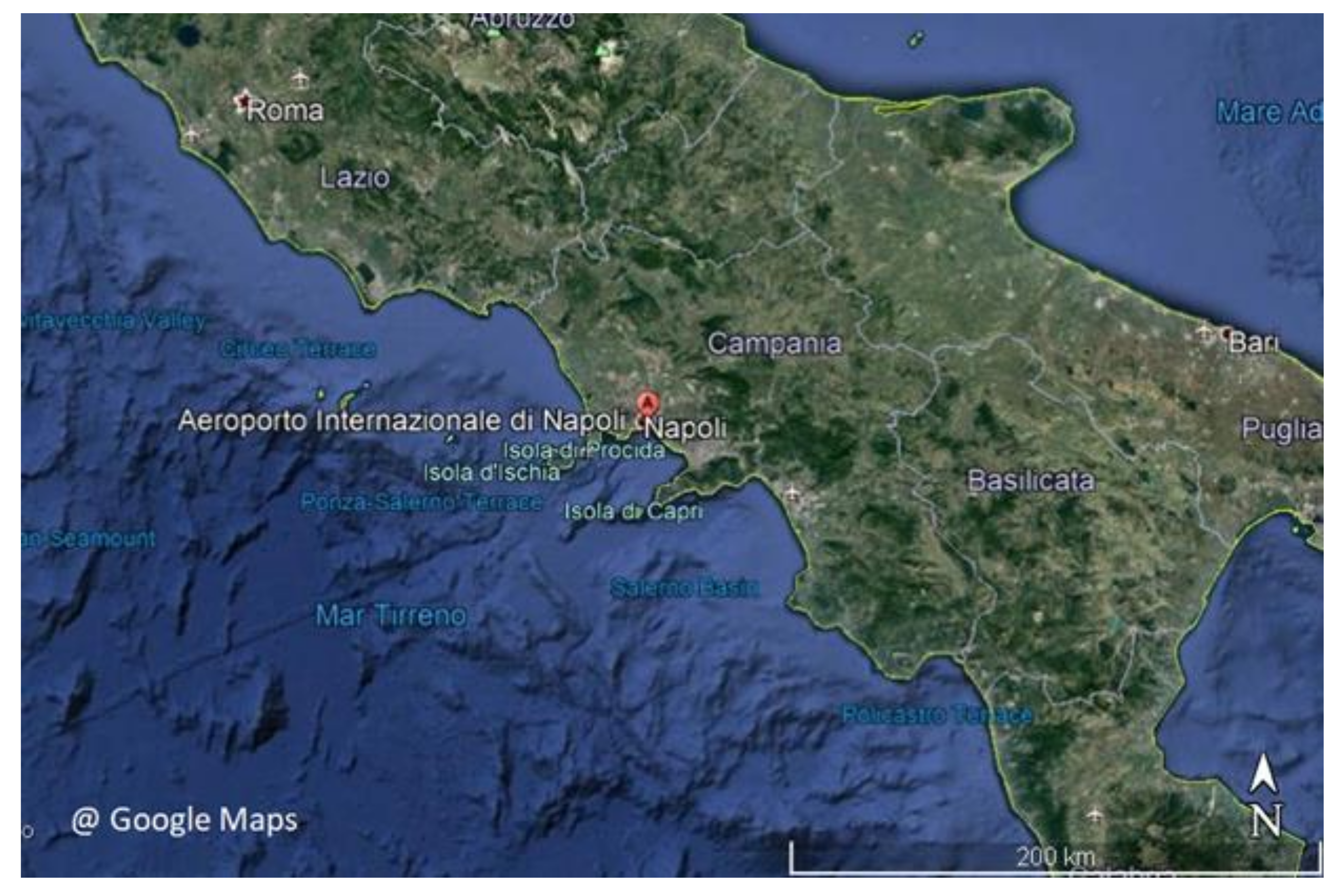
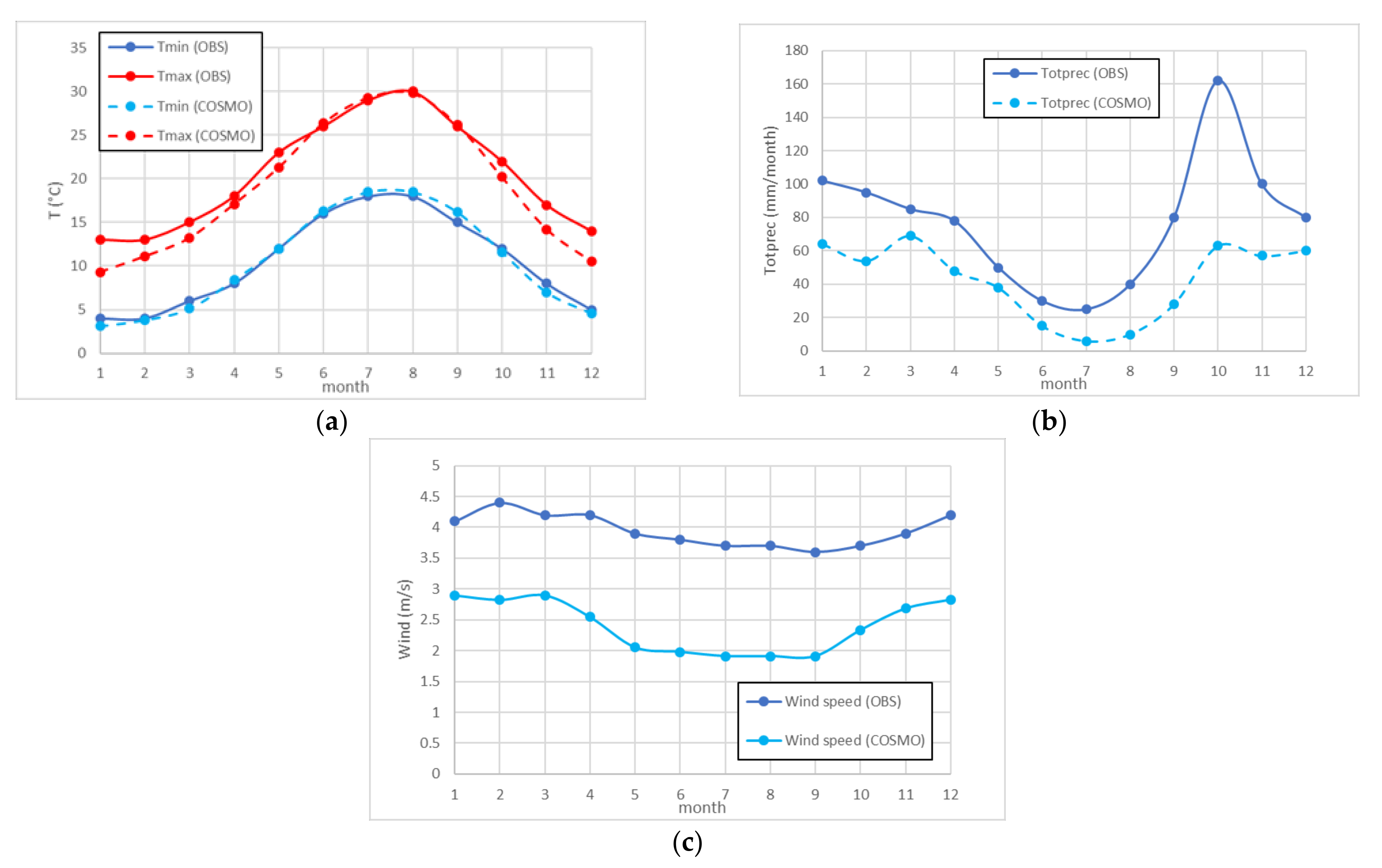
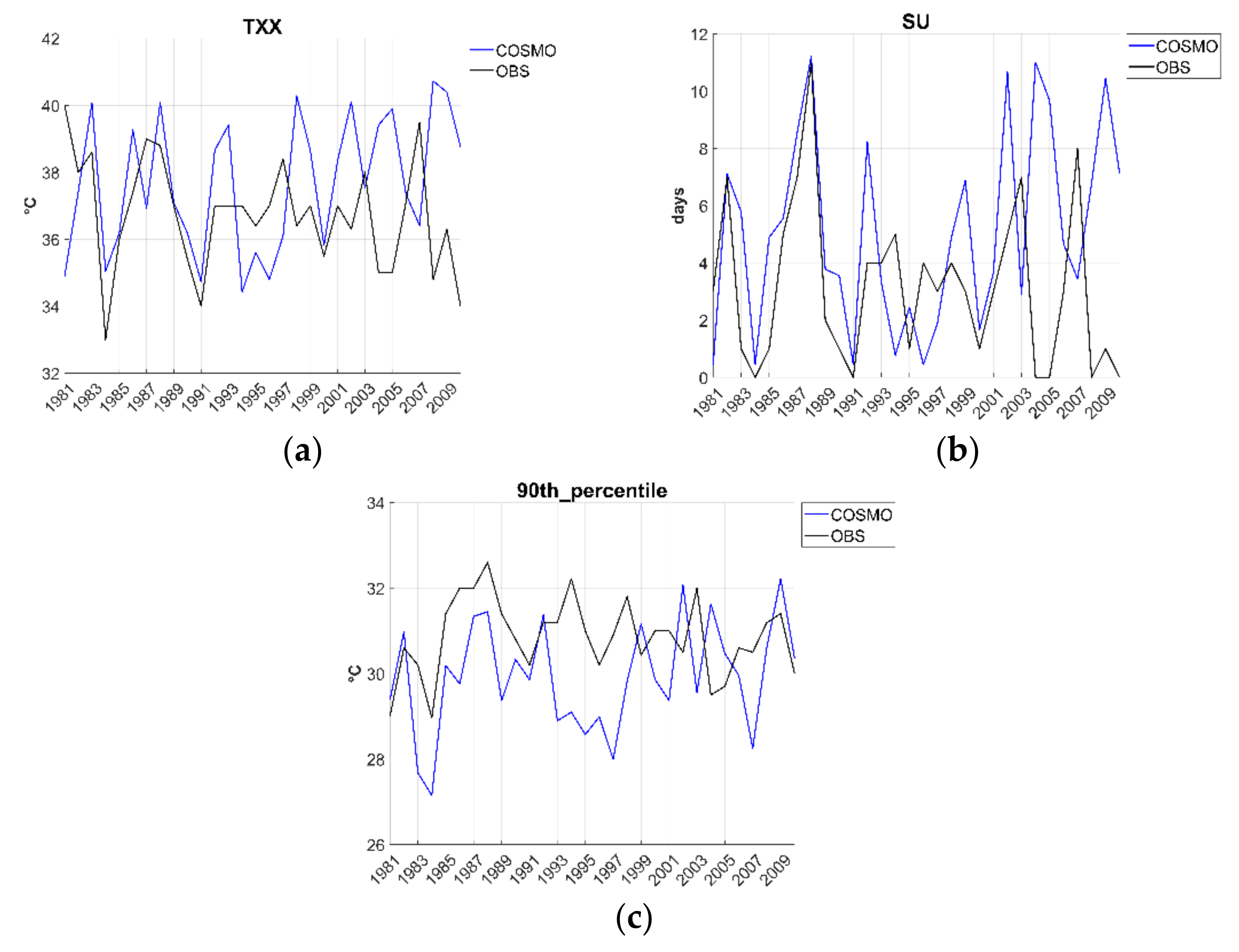
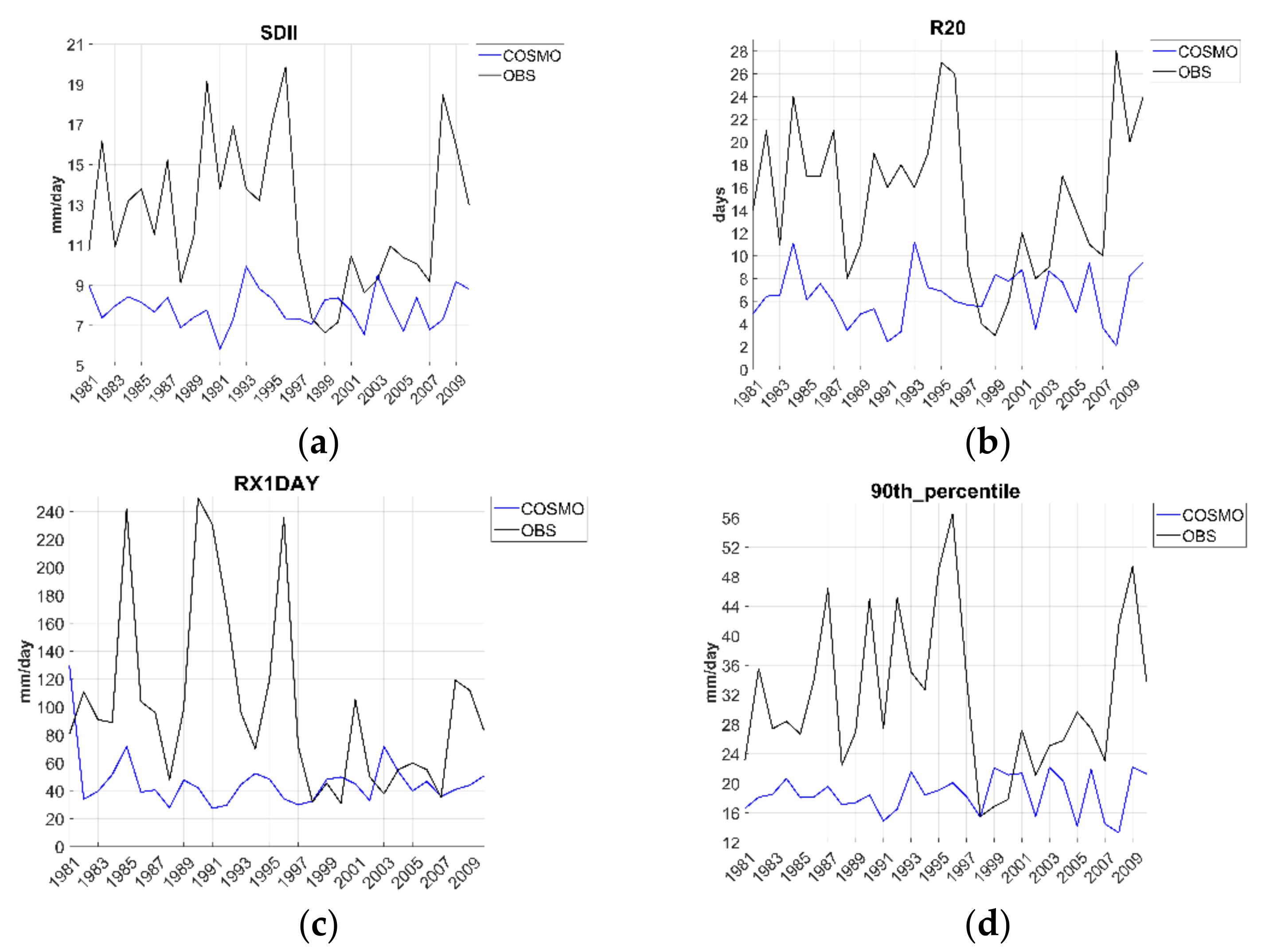
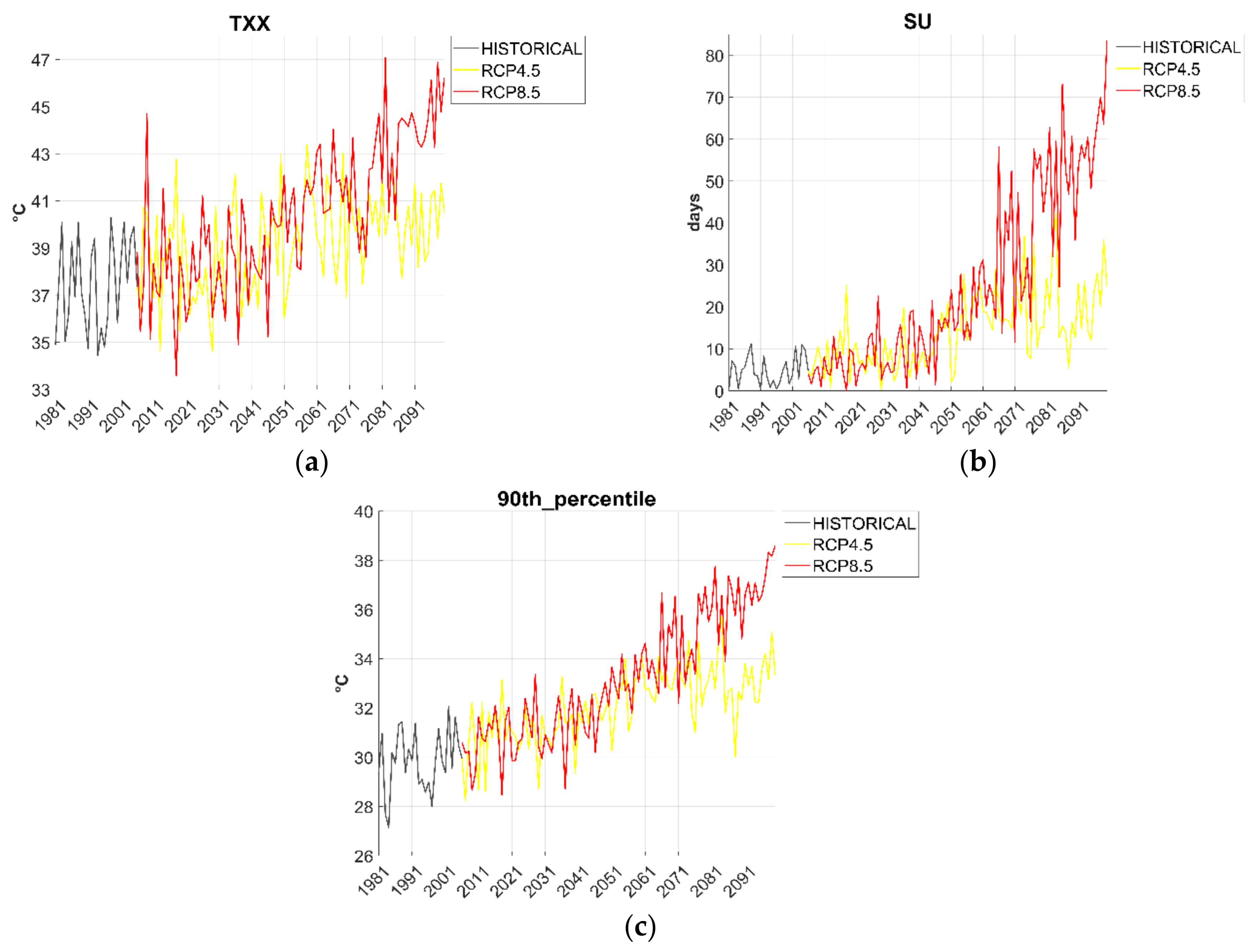
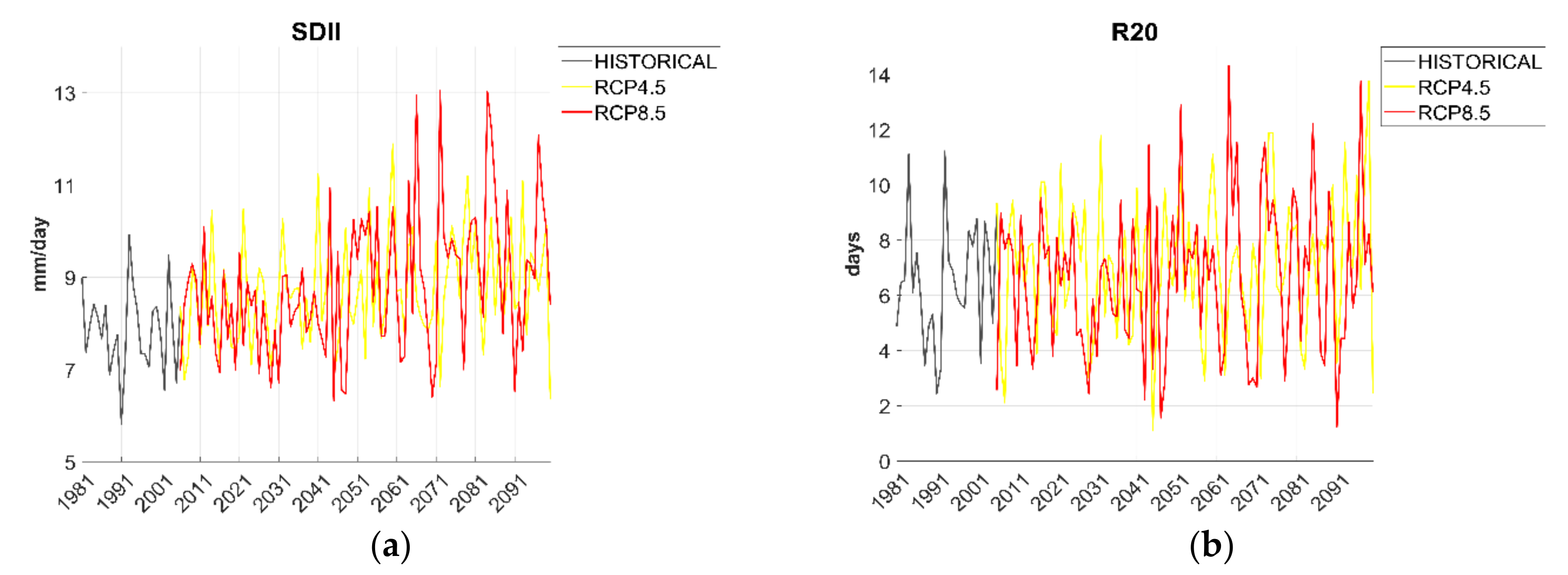
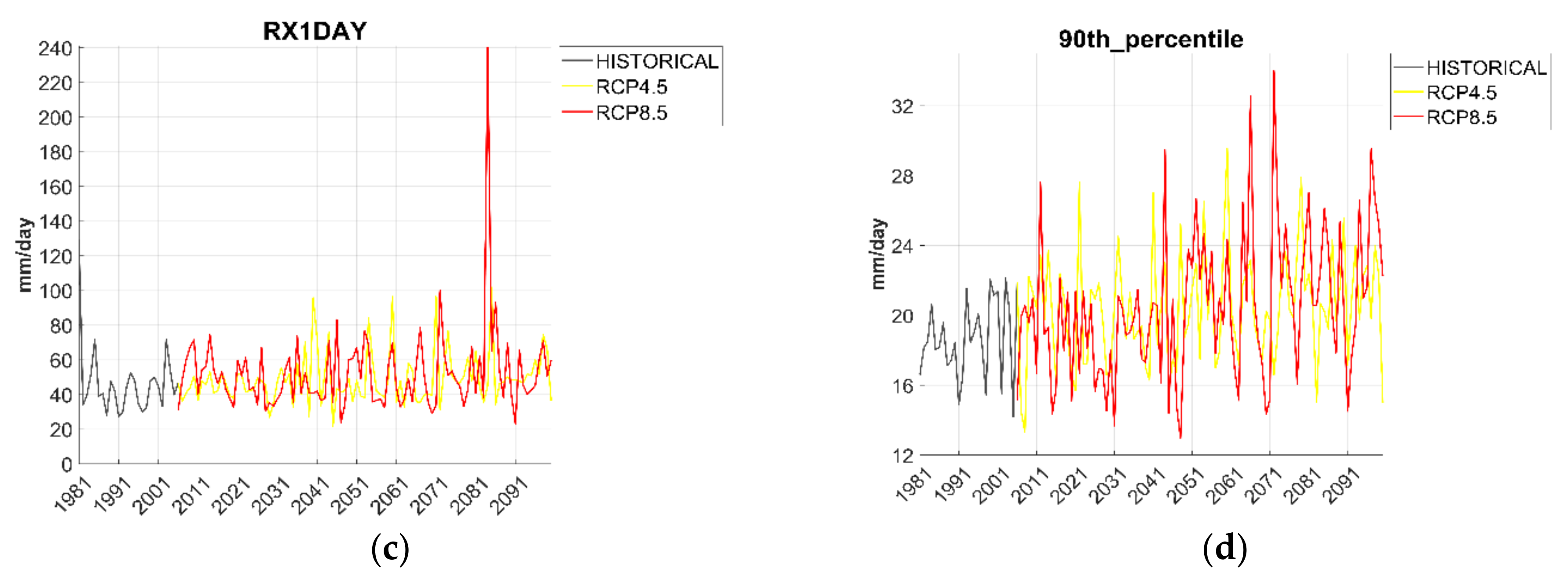
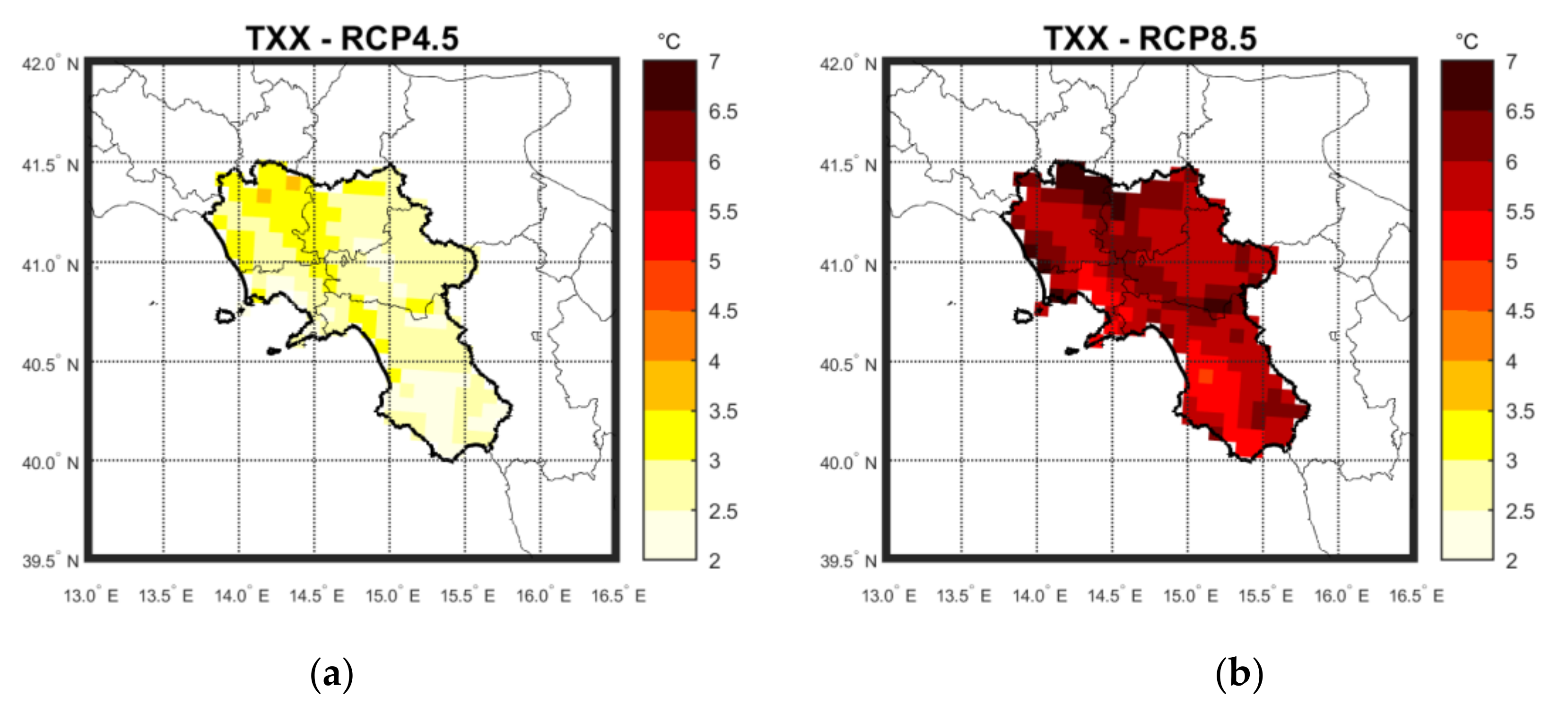
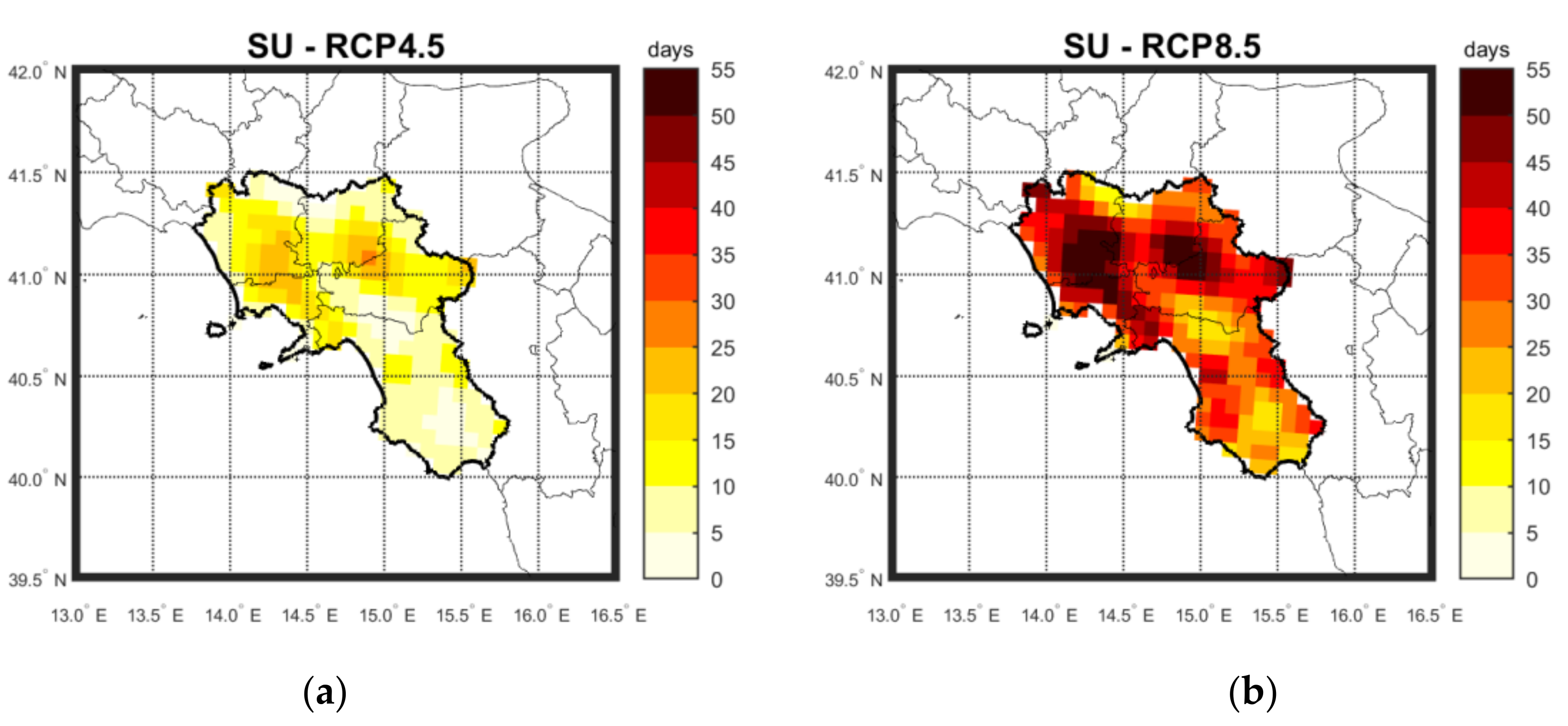
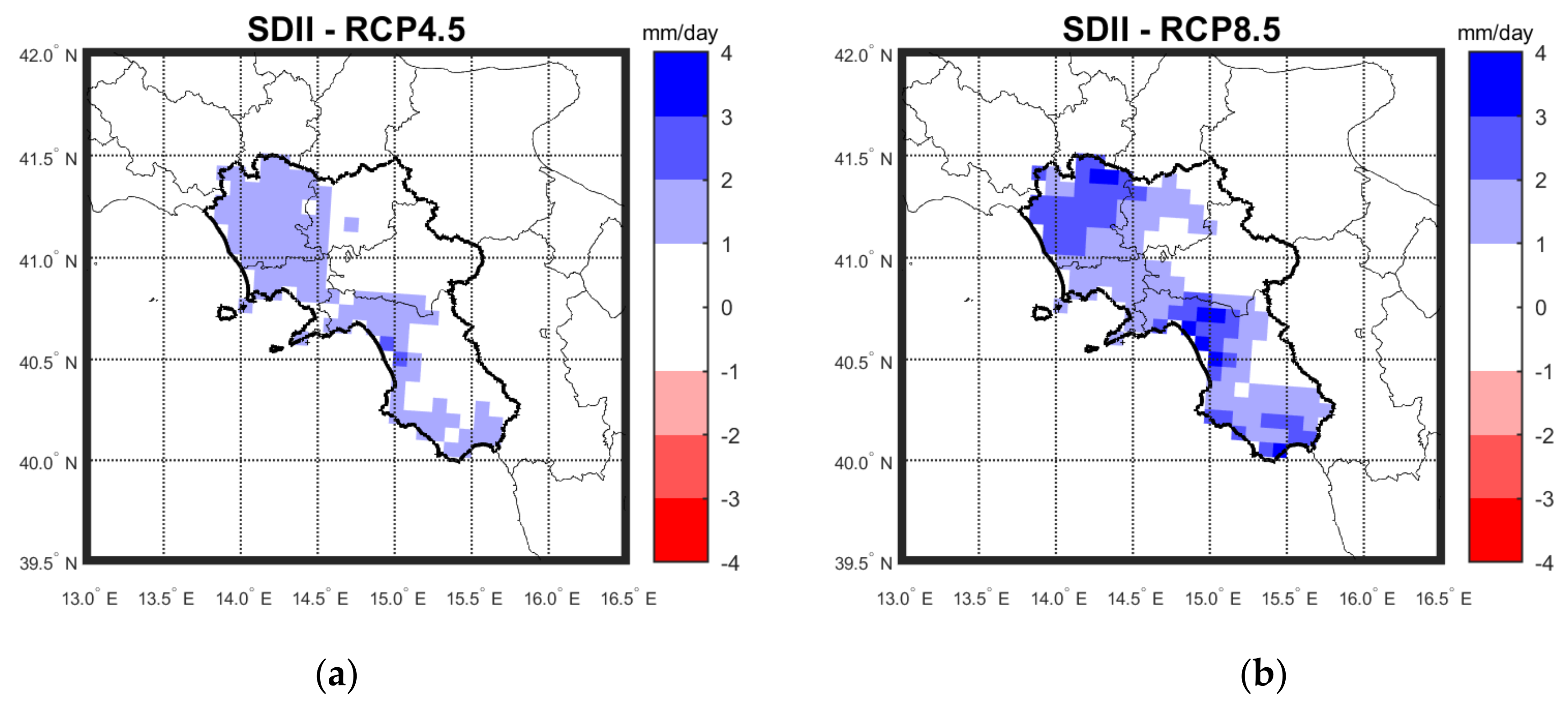
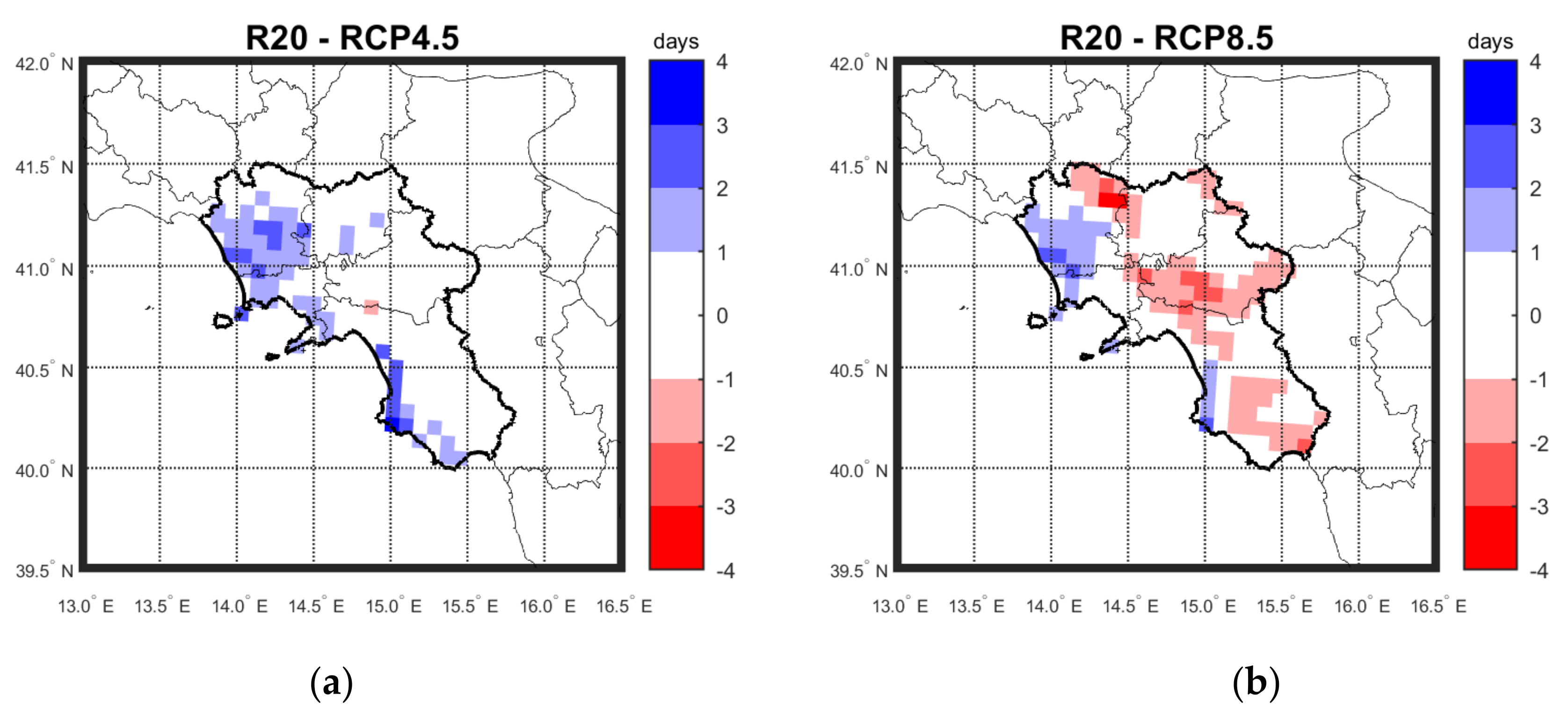
| Climate Extreme | Impact | Consequences |
|---|---|---|
| Cold temperature (T < 0°) | Slipperiness (ice formation, form of precipitation: rain/sleet/snowfall) Occurrence of freezing drizzle | Hazard for aviation and road traffic. Premature deterioration of road and runway pavements |
| Snowfall (>1 cm/24 h) | Slipperiness, troubles. The shallow snow layer might melt and then form an icy layer (if the road is not salted), for example after sunset | Increased accident rate |
| Wind gust (>25 m/s) | Reduced ground speed, reduced landing rate, reduced lift | Prolonged electricity cuts, delays and cancellations in air traffic |
| High temperature (T > 35°) | Heat damage to surface | Surface melting |
| Heavy precipitation (>20 mm/day) | Water rises to street level from drains | Damaged roads. Separation distance between aircraft. Delays |
| Hail (diameter > 5 cm) | Route blocked, airport closed; loss of situational awareness | Delays, diversion, accident, incident, ground damage |
| Lightning | Route blocked, airport ground operation interrupted, loss of situation awareness | Delays, diversion, accident, incident, maintenance, ground damage |
| Low visibility (MOR < 5 km) | Separation between aircraft increased | Delays, flight cancelled, airport closed. |
| Turbulence, wind shear | Changes in altitude/attitude occur; variations in indicated air speed | Passenger discomfort; structural damages |
| Label | Description | Units |
|---|---|---|
| TXx | Annual maximum value of daily—maximum temperature | °C |
| SU | Summer days—annual count of days when the daily Tmax is above 35° | days/year |
| 90p-Tmax | 90th percentile of daily Tmax | °C |
| SDII | Mean precipitation in wet days (prec > 1 mm/day) | mm/day |
| R20 | Number of days with precipitation > 20 mm/day | days/year |
| Rx1day | Maximum of daily precipitation | mm/day |
| 90p-Prec | 90th percentile of daily precipitation considering only the wet days (>1 mm) | mm/day |
| FG | Daily wind speed | m/s |
| Tmax (°C) | Tmin (°C) | Precipitation (mm/month) | Wind (m/s) | |
|---|---|---|---|---|
| Mean observed val. | 20.5 | 10.5 | 77 | 3.9 |
| Mean bias | −1.5 | −0.1 | −22 | −1.6 |
| RMSE | 1.9 | 0.6 | 41 | 1.5 |
| Standard Deviation | Trend | |||
|---|---|---|---|---|
| COSMO | OBS | COSMO | OBS | |
| TXx | 2.0 | 1.7 | 0.06 | −0.05 |
| SU | 3.4 | 2.8 | 0.10 | −0.06 |
| 90p-Tmax | 1.2 | 0.9 | 0.04 | 0.0 |
| SDII | 1.1 | 3.6 | 0.0 | −0.07 |
| R20 | 2.8 | 6.8 | 0.0 | −0.06 |
| Rx1day | 28.1 | 63.8 | −0.94 | −2.48 |
| 90p-Prec | 2.6 | 10.5 | 0.03 | −0.02 |
| Catastrophic | Hazardous | Major | Minor | Negligible | |
|---|---|---|---|---|---|
| Frequent | 5A | 5B | 5C | 5D | 5E |
| Occasional | 4A | 4B | 4C | 4D | 4E |
| Remote | 3A | 3B | 3C | 3D | 3E |
| Improbable | 2A | 2B | 2C | 2D | 2E |
| Extremely improbable | 1A | 1B | 1C | 1D | 1E |
Publisher’s Note: MDPI stays neutral with regard to jurisdictional claims in published maps and institutional affiliations. |
© 2021 by the authors. Licensee MDPI, Basel, Switzerland. This article is an open access article distributed under the terms and conditions of the Creative Commons Attribution (CC BY) license (https://creativecommons.org/licenses/by/4.0/).
Share and Cite
Bucchignani, E.; Zollo, A.L.; Montesarchio, M. Analysis of Expected Climate Extreme Variability with Regional Climate Simulations over Napoli Capodichino Airport: A Contribution to a Climate Risk Assessment Framework. Earth 2021, 2, 980-996. https://doi.org/10.3390/earth2040058
Bucchignani E, Zollo AL, Montesarchio M. Analysis of Expected Climate Extreme Variability with Regional Climate Simulations over Napoli Capodichino Airport: A Contribution to a Climate Risk Assessment Framework. Earth. 2021; 2(4):980-996. https://doi.org/10.3390/earth2040058
Chicago/Turabian StyleBucchignani, Edoardo, Alessandra Lucia Zollo, and Myriam Montesarchio. 2021. "Analysis of Expected Climate Extreme Variability with Regional Climate Simulations over Napoli Capodichino Airport: A Contribution to a Climate Risk Assessment Framework" Earth 2, no. 4: 980-996. https://doi.org/10.3390/earth2040058
APA StyleBucchignani, E., Zollo, A. L., & Montesarchio, M. (2021). Analysis of Expected Climate Extreme Variability with Regional Climate Simulations over Napoli Capodichino Airport: A Contribution to a Climate Risk Assessment Framework. Earth, 2(4), 980-996. https://doi.org/10.3390/earth2040058







